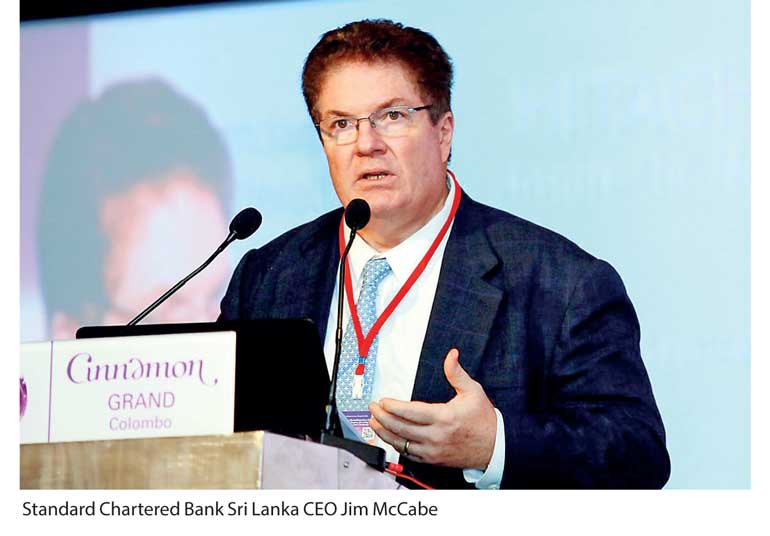Thursday Mar 13, 2025
Thursday Mar 13, 2025
Wednesday, 20 September 2017 00:00 - - {{hitsCtrl.values.hits}}
 By Shenali De Silva
By Shenali De Silva
Millennials have becoming an increasingly important demographic, globally. In the United States alone they have been identified as the largest population cohort in US history, outnumbering the previous ‘baby boomer’ generation.
Millennials, identified as those born between 1980 and 2000 and fall between the age groups of 17 and 37, form approximately 38% of the population in Sri Lanka and account for majority of the working age population. This segment has become very important to all sectors of the economy, and particularly to banking and finance.
Jim McCabe, CEO of Standard Chartered Bank Sri Lanka and member of the Ceylon Chamber’s National Agenda Committee on Finance and Capital, speaks to Shenali De Silva (Research Associate, Economic Intelligence Unit) about what banks need to do to remain relevant to millennials. He outlined five key considerations for banks – in planning, strategising, and investing – to serve millennial customers better.
The manner in which retail banking is conducted is likely to change dramatically due to the expectations and  manner in which millennials prefer to engage with banks. The asset side of retail banking has had minimal disruption over the past few years and is unlikely to drastically change over the course of the next five years. However, the service aspect of retail banking is likely to experience a dramatic change due to the nature in which tech savvy millennials prefer to communicate and conduct their banking activities.
manner in which millennials prefer to engage with banks. The asset side of retail banking has had minimal disruption over the past few years and is unlikely to drastically change over the course of the next five years. However, the service aspect of retail banking is likely to experience a dramatic change due to the nature in which tech savvy millennials prefer to communicate and conduct their banking activities.
Local banks will be at the forefront of engaging this particularly demanding group of individuals as foreign banks are not actively targeting the mass market. Rather, these international banks will have a city-oriented strategy, serving this particular class of individuals primarily through the corporates which employ them. Therefore, local banks will have the advantage of gaining access to the larger market.
Given that these individuals prefer engaging with technology, local banks need to be mindful that the importance of branches and the branch network to these individuals would dwindle over time. Amidst the fast growing number of millennials who are demanding in nature, banks need to also be mindful of the Baby Boomer (individuals born between the years 1946 and 1964) and Gen X population (individuals born between the years 1964 and 1981) that continue to be largely dependent on branches and the security and confidence inspired by the physical structure of these institutions.
Good service is important to millennials. Millennials aren’t brand or price conscious, and the key selling point to these individuals would be how efficiently a bank can serve them. Therefore, banks should focus on improving branch operations and improving how they engage with customers, how well they understand their customers and how well they cater to their customer’s needs.
The ease of operation and the ease of doing business via technology is key to millennials as they despise waiting in line. Millennials are known to be impatient and expect to be served swiftly and efficiently. This generation of individuals are not accustomed to time consuming bureaucratic processes or waiting in line to complete a task. Therefore ensuring that technology is deployed correctly and that front-end staff are trained to meet the demands of this generation will be critical to building long lasting relationships with these folk.
“Millennials hate standing in line for anything, because they haven’t stood in line for the first twenty- twenty five years of their life anyway, they are not about to do that now. They grew up in a world that gave them everything they want instantaneously. They want financial services that are intuitive, they don’t value branches as much.”
Millennials are a generation that have experienced an economic downturn and have also been actively involved in the recovery process. They are also a generation burdened with student loans and are not accustomed to saving. Therefore, interest rates are of little consequence to these individuals presently, rather their focus would be on transaction costs, offers, rewards and subscription fees.
“Millennials do admit to not being very loyal. They admit to being frivolous and attracted to things that don’t seem that important to the generations before them.”
Understanding these traits would be key to capitalising on the spending trends of these individuals. Effectively communicating the bank’s value proposition would be key to effectively serving millennials. Banks would need to avidly invest in social media, applications and other new age communication channels to effectively communicate what they have to offer. Feedback therefore would be critical to understanding how effectively a customer is served and what products and services are expected from banks. Leveraging communication channels such as social media to receive feedback would help build better a better relationship with this generation who are known to be candid, forthright and highly opinionated.
Understanding customers would be key to building long lasting relationships with millennials. Building a strong relationship with millennials early on would be crucial to banks as these individuals would eventually progress to saving and making larger investments. Developing these relationships therefore would essentially be investing in the future of the bank.
“You’re serving their needs now hoping that you’re building a relationship for the future.”
Bearing in mind that these individuals account for majority of the workforce and that they are not brand conscious and value the service provided to them above all else, the experiences they are exposed to likely to have a long lasting impression. Therefore, selling the service banks offer would in essence be selling the product as an all-encompassing package.
“It’s not going to be transactional in nature with us, they’re going to have to like the entire package.”
For foreign banks such as Standard Chartered, this is somewhat less challenging as their strategy is city focused and mass market penetration isn’t their primary objective. Therefore, the profile of the millennials they engage with would be somewhat similar as they would largely be city dwelling individuals, predominantly sharing the same socio-economic background. However, local banks which have a larger reach and cater to millennials of diverse socio-economic backgrounds need to understand their unique requirements and how to effectively utilise the technology they invest in to cater to these diverse groups.
As banks progress to offering better products and serviced investing in technology will be inevitable. Unlike baby boomers who believe that the physical structure of banks are an indicator of how secure and ‘safe’ a bank is, millennials evaluate security by a vastly different scale.
Safety of information and how complex and secure a bank’s IT system is, is a key consideration for this generation. Millennials are primarily concerned with how secure their data and information is, therefore banks need to ensure that their online offerings and processes are trustworthy in order build and maintain credibility among these new age customer. Online transactions particularly need to be secure and customer friendly user interfaces and user experience would be critical to retaining customers.
In order to build this trust investing in technology alone will not suffice, banks would also need to continuously update themselves on the latest technology available and make significant investments in training and development of IT personnel and staff. While investing in the right technology to better serve customers, banks need to mindful of not being made irrelevant by technology. Therefore, amalgamating the right technology with the right services and offering would be crucial.
“Online offerings have to work, they have to be trustworthy and credible. Millennials will say ‘I don’t want to use this service or this is the ugliest website I’ve seen, it takes 25 hours to transact, so why am I wasting my time?’”
Maintaining progressively increasing cost ratios while serving millennials who depend on technology and their predecessors who depend on a branch network will be a significant challenge to banks. Furthermore, as the industry continues to consolidate, maintaining control of the business and developing a focused strategy that continuously improves efficiency while developing a relationship with customers will be fundamental to remaining relevant in the industry.
(‘The National Agenda’ is the Ceylon Chamber of Commerce’s knowledge platform featuring insights from members of its National Agenda Committees on Infrastructure, Energy, Logistics and Transport, Innovation, and Finance and Capital. Visit nationalagendacommittees.wordpress.com.)
Discover Kapruka, the leading online shopping platform in Sri Lanka, where you can conveniently send Gifts and Flowers to your loved ones for any event including Valentine ’s Day. Explore a wide range of popular Shopping Categories on Kapruka, including Toys, Groceries, Electronics, Birthday Cakes, Fruits, Chocolates, Flower Bouquets, Clothing, Watches, Lingerie, Gift Sets and Jewellery. Also if you’re interested in selling with Kapruka, Partner Central by Kapruka is the best solution to start with. Moreover, through Kapruka Global Shop, you can also enjoy the convenience of purchasing products from renowned platforms like Amazon and eBay and have them delivered to Sri Lanka.
Discover Kapruka, the leading online shopping platform in Sri Lanka, where you can conveniently send Gifts and Flowers to your loved ones for any event including Valentine ’s Day. Explore a wide range of popular Shopping Categories on Kapruka, including Toys, Groceries, Electronics, Birthday Cakes, Fruits, Chocolates, Flower Bouquets, Clothing, Watches, Lingerie, Gift Sets and Jewellery. Also if you’re interested in selling with Kapruka, Partner Central by Kapruka is the best solution to start with. Moreover, through Kapruka Global Shop, you can also enjoy the convenience of purchasing products from renowned platforms like Amazon and eBay and have them delivered to Sri Lanka.